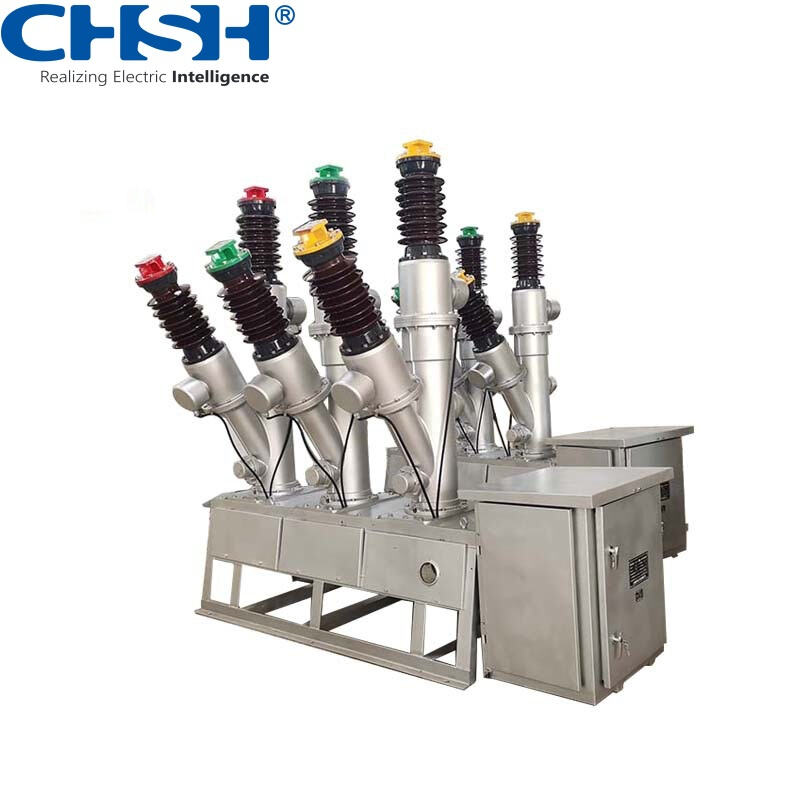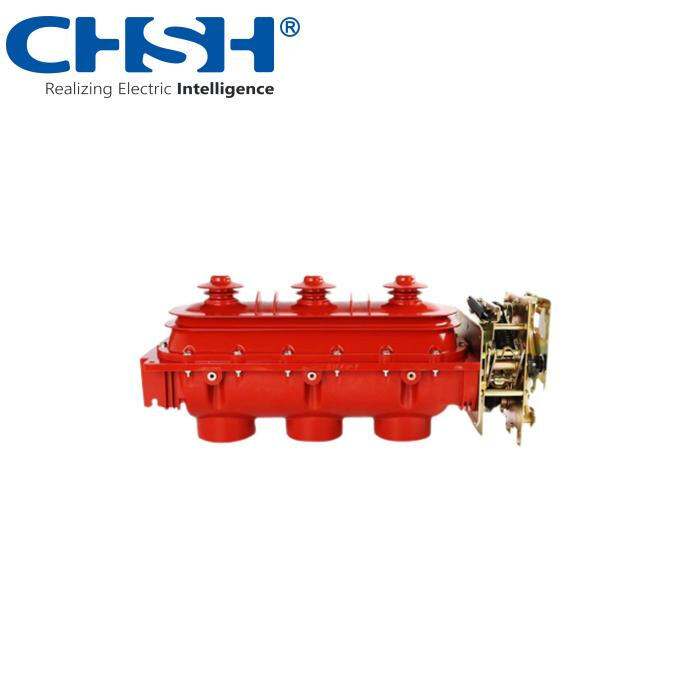Circuit Breaker Selection Guide: How to Choose Between SF6/Vacuum Types for Your Power System
Circuit Breakers are essential components in electrical power systems, providing the ability to safely interrupt current flow during faults and protect both equipment and personnel. Choosing the right type of breaker is crucial for ensuring system reliability, safety, and efficiency. In medium-voltage applications, two leading technologies dominate: SF6 Circuit Breakers and Vacuum Circuit Breakers. Each has its advantages, limitations, and ideal applications.
This guide will walk you through the fundamental differences between SF6 and vacuum technologies, the selection factors to consider, and how to match the right Circuit Breakers to your specific power system requirements.
Understanding Circuit Breakers in Power Systems
Circuit Breakers serve two primary purposes:
To interrupt current flow in the event of an overload or short circuit.
To provide a means for manually disconnecting equipment for maintenance or operational changes.
While all Circuit Breakers perform these basic functions, the technology used to extinguish the arc when contacts open is a defining feature.
SF6 Circuit Breakers: Technology Overview
SF6 (sulfur hexafluoride) Circuit Breakers use pressurized SF6 gas as both the insulating and arc-quenching medium. When the breaker contacts separate, an arc forms. The SF6 gas quickly cools and de-ionizes the arc, extinguishing it efficiently.
Key Features of SF6 Circuit Breakers
Exceptional dielectric strength, allowing compact designs.
High interrupting capacity, making them suitable for heavy-duty applications.
Low noise operation during switching.
Stable performance across a wide range of environmental conditions.
Limitations
SF6 is a potent greenhouse gas with a global warming potential thousands of times higher than CO₂.
Requires specialized handling and gas recovery systems.
Periodic monitoring of gas pressure is necessary to maintain performance.
Vacuum Circuit Breakers: Technology Overview
Vacuum Circuit Breakers extinguish arcs in a sealed vacuum interrupter. When contacts open, the vacuum prevents the arc from sustaining, allowing rapid interruption.
Key Features of Vacuum Circuit Breakers
Very fast arc extinction, reducing wear on contacts.
No flammable or greenhouse gases.
Minimal maintenance, with interrupters sealed for life.
Long mechanical and electrical life.
Limitations
Slightly lower interrupting capacity compared to SF6 in very high-voltage applications.
Larger physical size at higher voltages compared to SF6 units.

Comparing SF6 and Vacuum Circuit Breakers
When deciding between SF6 and vacuum technologies, it’s essential to evaluate them across several performance and operational factors.
Arc Quenching
SF6: Excellent arc quenching in high-voltage, high-current situations.
Vacuum: Very fast arc extinction for medium-voltage systems, with minimal contact erosion.
Environmental Impact
SF6: High global warming potential; requires leak prevention and gas recycling.
Vacuum: No greenhouse gases, environmentally friendly.
Maintenance Requirements
SF6: Requires gas pressure monitoring and periodic refilling or gas recovery.
Vacuum: Almost maintenance-free interrupters; only mechanical parts need occasional servicing.
Lifespan
SF6: Long lifespan with proper maintenance but dependent on gas system integrity.
Vacuum: Extremely long operational life, often exceeding 30,000 mechanical operations.
Application Range
SF6: Preferred for high-voltage (above 36 kV) and heavy-duty applications.
Vacuum: Best suited for medium-voltage (up to 36 kV) applications and locations requiring minimal maintenance.
Selection Factors for Circuit Breakers
Choosing the right breaker involves balancing technical, operational, and environmental considerations.
1. System Voltage and Current Ratings
Determine the maximum operating voltage and fault current levels. SF6 Circuit Breakers are better suited for higher voltages and currents, while Vacuum Circuit Breakers excel in medium-voltage ranges.
2. Operating Environment
Consider temperature extremes, humidity, dust, and exposure to corrosive atmospheres. SF6 breakers perform consistently in harsh climates, but vacuum breakers offer advantages in clean, indoor installations.
3. Environmental Regulations
If your project is in a region with strict environmental rules, the absence of greenhouse gas emissions makes Vacuum Circuit Breakers a more sustainable choice.
4. Maintenance Resources
Facilities with limited maintenance personnel and budgets benefit from the low-maintenance nature of vacuum technology. SF6 systems require trained staff for safe gas handling.
5. Installation Space
SF6 units often have a more compact footprint for high-voltage ratings. Vacuum units for the same rating may require slightly more space.
6. Lifecycle Costs
While SF6 breakers may have lower initial costs for certain applications, vacuum breakers can offer lower total cost of ownership due to reduced maintenance and longer operational life.
Application Scenarios
Urban Medium-Voltage Distribution
Vacuum Circuit Breakers are often the first choice due to their safety, low maintenance, and environmental benefits.
High-Voltage Transmission Substations
SF6 Circuit Breakers dominate in these applications because of their ability to handle high interrupting capacities in a compact design.
Renewable Energy Integration
Vacuum Circuit Breakers are increasingly used in wind and solar farms, where environmental impact is a major consideration.
Industrial Facilities
Both types can be suitable depending on voltage level and operational requirements. Vacuum technology is preferred for frequent switching operations.
Technological Advancements
Hybrid Solutions
Some manufacturers are developing hybrid breakers that combine vacuum interrupters with SF6 or other media to optimize performance and environmental impact.
Eco-Friendly Alternatives to SF6
Research is ongoing into gases with lower global warming potential, such as g³ (Green Gas for Grid), to replace SF6 in certain applications.
Digital Monitoring and Diagnostics
Both SF6 and Vacuum Circuit Breakers now come with smart monitoring options, enabling predictive maintenance and improving system reliability.
Installation and Operational Best Practices
Regardless of type, all Circuit Breakers should be installed and operated according to best practices:
Ensure proper insulation clearances and grounding.
Follow manufacturer torque specifications for connections.
Conduct regular functional and insulation resistance tests.
For SF6 breakers, monitor gas pressure and check for leaks.
For vacuum breakers, inspect mechanical operating parts periodically.
Future Outlook
The selection between SF6 and Vacuum Circuit Breakers will continue to evolve as technology advances and environmental regulations tighten. While SF6 remains dominant in high-voltage transmission, vacuum technology is steadily advancing into higher voltage ranges, potentially replacing SF6 in some applications in the future.
Utility companies, industrial operators, and infrastructure developers will increasingly weigh environmental impact alongside technical performance in their selection process. The industry’s push toward carbon-neutral operations will likely accelerate the adoption of vacuum technology and eco-friendly alternatives to SF6.
Conclusion
Selecting the right Circuit Breakers for your power system requires a careful balance of technical requirements, environmental considerations, maintenance capabilities, and cost analysis. SF6 Circuit Breakers offer unmatched performance in high-voltage, high-current applications, while Vacuum Circuit Breakers provide exceptional safety, efficiency, and environmental benefits in medium-voltage networks.
Understanding the strengths and limitations of each technology ensures that your power system remains reliable, safe, and future-ready. As innovations continue, both technologies will see improvements, but the trend toward sustainability will likely make vacuum technology an increasingly attractive choice in the years ahead.
FAQ
Are Vacuum Circuit Breakers suitable for outdoor installations?
Yes, when housed in weatherproof enclosures or outdoor-rated switchgear, they perform reliably in various climates.
Is SF6 dangerous to handle?
SF6 is non-toxic in its pure form but can form harmful byproducts during arcing. Safe handling and gas recovery procedures are essential.
Can Vacuum Circuit Breakers replace SF6 breakers in existing installations?
Often yes, but retrofitting requires compatibility checks for mechanical and electrical parameters.
Which breaker type is better for frequent switching operations?
Vacuum Circuit Breakers handle frequent operations better due to lower contact wear.
Will SF6 be phased out?
Regulatory pressure and environmental initiatives are pushing for alternatives, but SF6 is still widely used in high-voltage applications.
Table of Contents
- Circuit Breaker Selection Guide: How to Choose Between SF6/Vacuum Types for Your Power System
- Understanding Circuit Breakers in Power Systems
- SF6 Circuit Breakers: Technology Overview
- Vacuum Circuit Breakers: Technology Overview
- Comparing SF6 and Vacuum Circuit Breakers
- Selection Factors for Circuit Breakers
- Application Scenarios
- Technological Advancements
- Installation and Operational Best Practices
- Future Outlook
- Conclusion
- FAQ

